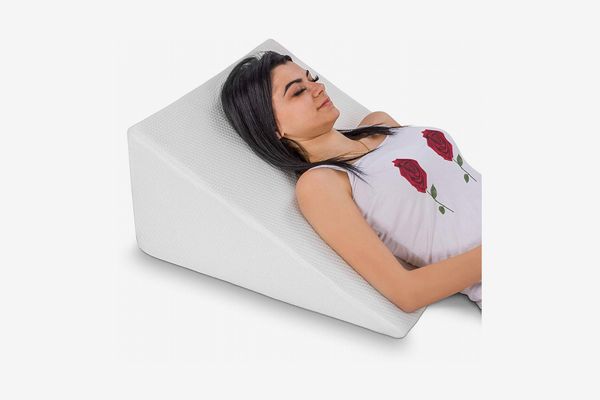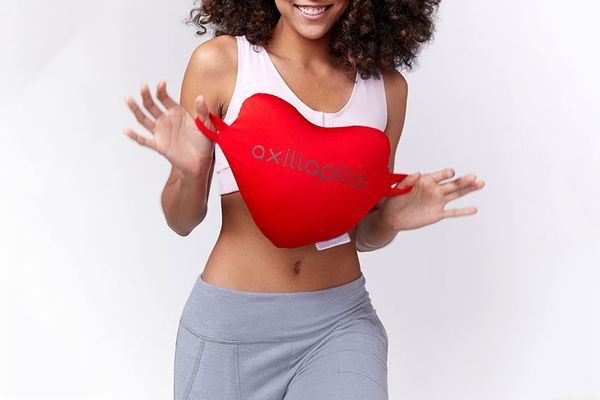
Last September, at 28 years old, I was weeks into an MBA program when I got the phone call that would turn my world upside down: I had breast cancer. I had no family history of the disease and felt the healthiest I ever had — to say I was shocked would be the world’s greatest understatement.
Cancer treatment moves quickly. Before I could even pack up my apartment or say good-bye to my friends, I was back with my family preparing for the fight of my life. I had a 2.5 cm rapidly growing tumor that required 12 rounds of intensive chemotherapy. On top of that, doctors discovered a mutation in my ATM gene (meaning I’m more susceptible to breast cancer than the general population), so I made the incredibly difficult but also mind-blowingly simple decision to get rid of my ticking-time-bomb boobs altogether. That required a full double mastectomy followed by what’s called an “autologous reconstruction” procedure (instead of using implants, surgeons built my new breasts from my belly — jealous?). Then came an emergency surgery for a hematoma (long story). Needless to say, I became a regular on the operating table.
Through all of this, social media ended up being a surprising savior. Sharing my story on Instagram introduced me to hundreds of others in similar situations. I talked to dozens of different women about the hacks and products that helped them get through their hospital stays and eased their discomfort after surgery. Following my first operation, I compiled all of my “must-haves” into a list that I subsequently shared on Instagram. Slowly but surely, more and more people reached out to me about it. Statistically, that’s not so surprising: One in eight women gets breast cancer, so at some point, we all will likely know someone battling it.
Still, it can be hard to know what gifts are appropriate to give to patients . Below is my list of products to make one seriously unfortunate situation a hell of a lot more comfortable. (And these don’t apply only to mastectomy patients; they’re appropriate for all types of breast-cancer surgeries.)
Pillows
The various pillows I used during recovery are perhaps the most important items on this list (I slept in bed with all of them after my mastectomy). A wedge pillow reduces the strain of getting up because it positions you at a steep angle. I recommend this one because its memory-foam body is comfortable against you while still managing to stay very firm. I liked it so much I hung on to it; now I use it when I’m vegging out and watching TV in bed.
During my recovery, I needed to put something more supportive than a regular old pillow beneath my knees to encourage blood flow and ease the pressure on my lower back. So I bought this bolster (which I’d already been coveting for my yoga practice). Its consistency is nice and firm, and the machine-washable cover makes it easy to freshen up.
Small pillows are a necessity for keeping your arms relaxed and separated from your torso post-surgery (which you’ll want to do because of tenderness in the breast area and the removal of any lymph nodes). The Axillapilla is made specifically for this purpose; its heart shape lets it fit perfectly under your armpits.
Yes, you are reading this correctly: The U shape of a traditional pregnancy pillow makes it the perfect tool for side sleeping (once it is allowed) post-surgery. You want to avoid rolling over and putting undue pressure on the breast area, and these pillows provide a barrier to prevent that. I like this one because it’s firm enough to be supportive but malleable enough to twist into whatever position is most comfortable.
The last and final pillow is (in my opinion) the most important one for back sleepers like me. I found the only way to not feel like I was lying ramrod-straight on my back post-surgery was to put a travel pillow around my neck in addition to the pillows under my head. But not just any travel pillow — the fancier ones I had lying around from previous trips had design details (fuzzy exteriors, adjustable straps) that rendered them unusable. This simple style, however, offered just the right amount of comfort and support.
Gear
Hydration is essential immediately following breast surgery, but lifting a cup or water bottle can be uncomfortable. Sipping from a straw helps to avoid that. Still, we don’t want to hurt the environment, which is why this glass water bottle that comes with its own straw is the one I kept by my side for most of my treatment. Aside from its function, I also like the bottle’s simple design and ease of cleaning.
This is the kind of thing you don’t think of until it’s too late. Hospital beds are not always situated close to outlets, but a ten-foot charging cable is usually long enough to reach the nearest one. I like this one’s gold color, which somehow seemed to make my hospital room a bit cheerier (it’s all about the little things).
Anyone who has been through major breast surgery will tell you the drive home from the hospital is one of the more difficult parts. But a seat-belt cover will help ease the pain of that bumpy ride. One of my “breasties” (a fellow survivor I met on Instagram) sent me this, and it made drives home from the hospital 1,000 percent more comfortable than they would’ve been otherwise.
I took more than 20 different pills a day after my reconstruction surgery. As you can imagine, that regimen can get confusing very fast, which is why I recommend patients or caretakers get a notebook they can use specifically to track doses. I’m a Moleskine fan (always have been), but any kind will do.
An eye mask is a must if you want to get any shut-eye immediately following surgery (hospitals are bright, and doctors are constantly shuffling in and out of your room). I love this one, which is made from the same supersoft wool Allbirds uses for its shoes. And unlike other eye masks (which often slip off my head at some point during slumber), it’s not flimsy and stays in place.
Beauty products
It is not uncommon to be banned from showering for at least a week after surgery. I was introduced to the (Strategist-approved) Tangle Teezer brush during my “cold-capping” treatments (when you wear what’s essentially a frozen hat to save your hair during chemo), and it is a lifesaver — particularly after surgery, when being bedridden and shower free can result in massive clumps. This thing truly flies through serious tangles like you wouldn’t believe; it’s unlike any other brush I’ve ever had.
A good dry shampoo helps to keep hair feeling fresh. This one doesn’t leave behind the white residue that some other dry shampoos do after days of use, making it a favorite of mine.
One of the unfortunate after-effects of general anesthesia is uncomfortably dry skin (which can last for weeks), making a robust facial moisturizer an essential. This one is my personal favorite — post-diagnosis, I’ve gone through a bit of a “clean beauty” journey to eliminate toxins from my daily routine, and this moisturizer really takes the cake when it comes to being clean and effective.
Apparel
Leaning over to tie your shoes isn’t an option after surgery, which is why a good pair of slippers you can use to do laps around hospital hallways and walk outside upon discharge is key. I brought along my trusty pair of UGG Dakotas, which are great because they have treads on the bottom for minimal slippage indoors and out.
While recovering, you’ll find that your range of arm motion is restricted for weeks (lifting them above your head to put on a shirt is out of the question), so button-down pajamas are an essential. My favorite sets are from Eberjey, which I think makes the softest pajamas out there. Softness is key because when you’re stuck in bed, comfy PJs can make all the difference. I recommend buying a short set (shorts and a short-sleeve shirt) and a long set (long pants and long-sleeve shirt) since hospital climate control can be finicky.
A good bathrobe is a must for strolls up and down hospital hallways. I recommend this one, designed specifically to be worn after surgery, because it contains a belt to hold post-op fluid drains (which can be in for one to two weeks).
If your procedure doesn’t require many (or any) fluid drains, then I’m a huge fan of this washable-silk robe, which has the most incredible, buttery fabric that doesn’t irritate scars.
AnaOno, which was founded by a breast-cancer survivor, makes a variety of bras designed specifically for patients and survivors. Depending on the procedure and need for compression afterward, wearing a bra 24/7 may be required (postmastectomy, I had to wear one around the clock, but after my autologous-reconstruction procedure, I went bra free for six weeks). If a bra is indeed a necessity, I suggest this style, which buckles down the front. A lot of people are constantly checking on the state of your boobs, so you’re going to want easy access!
The Strategist is designed to surface the most useful, expert recommendations for things to buy across the vast e-commerce landscape. Some of our latest conquests include the best acne treatments, rolling luggage, pillows for side sleepers, natural anxiety remedies, and bath towels. We update links when possible, but note that deals can expire and all prices are subject to change.
























